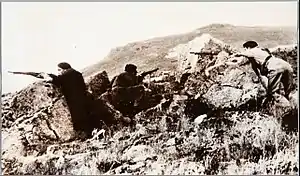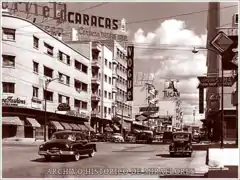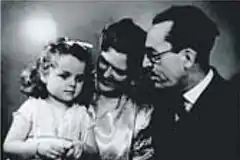Segismundo Casado
Segismundo Casado López (10 October 1893 – 18 December 1968) was a Spanish Army officer; he served during the late Restoration, the Primo de Rivera dictatorship and the Second Spanish Republic. Following outbreak of the Spanish Civil War he sided with the Republicans, gradually rising to commander of the Army of the Centre. He is best known as leader of the coup against the government of Juan Negrín; its objectives were preventing a Communist takeover and terminating fratricidal bloodshed during the war, considered already lost. The rebels seized control of the Republican zone; in their quasi-government Casado served as the minister of defense. Negotiations with the Nationalists failed; Casado went on exile, first to Britain and from 1947 to Latin America, returning to Spain in 1961.
Segismundo Casado López | |
|---|---|
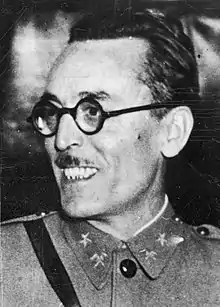 Segismundo Casado | |
| Birth name | Segismundo Casado López |
| Born | 10 October 1893 Nava de la Asunción, Segovia, Spain |
| Died | 18 December 1968 (aged 75) Madrid, Spain |
| Allegiance | |
| Service/ | |
| Rank | Colonel |
| Commands held | Commander of an Army Corps (1938), Commander of the Army of the Centre (1939) |
| Battles/wars | Spanish Civil War |
| Signature |  |
Military career
There is little clarity as to Casado's parents. Himself he claimed - and this information is reproduced by the Spanish Real Academia de la Historia - that his parents, Tomás Casado Arribas and Tomasa López Quinsano, were farmers, and that his father worked as bracero.[1] According to his own account during childhood and youth he suffered misery and it was thanks to extraordinary efforts of his parents that he managed to complete education in a local primary school. However, numerous other sources claim that his father was a military officer and served as an infantry captain.[2]
Junior officer
As an adolescent in 1907 Casado entered the Cavalry Academy in Valladolid.[3] Having completed the curriculum as 15th among 44 graduates, in 1911 he was promoted to segundo teniente.[4] Initially he was posted to Regimento Cazadores de Almansa, but was soon transferred to 4. Regimento de Caballería in Burgos; within this unit he was posted to 1. Deposito de Caballos Sementales in Jérez de la Frontera. In 1912 he was again transferred to Regimento de Lanceros del Príncipe. In 1913 he was promoted to teniente primero.[5] In 1912-1916 he followed various courses, e.g. at Curso de Escuela de Equitación Militar, Escuela Central de Tiro and Secciones de Obreros y Explosivos en lor Regimientos del Arma. In 1917 he was deployed with his regiment on public order duties during a general strike. In 1918 Casado entered Escuela Superior de Guerra; in 1919 he was promoted to captain.[6]
In 1921 Casado was transferred to Larache in Spanish Morocco and assigned to a machine-gun company, deployed mostly as protection of various logistics operations. He was appreciated by superiors, who in reports noted Casado's distinguished role in combat and in the rear. However, following less than half a year in Morocco in 1922 he was withdrawn from the line, and assigned to the Regimento Mixto de Artillería and then to the Comandancia General de Ceuta. In 1923 Casado received the General Staff diploma.
In 1924 Casado was recorded within the Alcalá de Henares garrison.[7] He assumed command of a squadron in the Regimento de Lanceros de la Reina in Madrid the following year. In 1928 he entered another military course intended for candidates to higher officer ranks,[8] and in 1929 he was promoted to comandante. A year later he was posted to the Escuela de Estudios Superiores (later Escuela Superior de Guerra), but this time as auxiliary professor at Curso de Táctica y Servicio de Estado Mayor. According to his own account, from the onset Casado opposed the Primo de Rivera dictatorship; documents confirm that in 1927 he defended in military court some individuals involved in the so-called Sanjuanada,[9] and in 1929 he represented in court the officers deemed engaged in rebellious activities in Ciudad Real.[10]
Senior officer
The advent of the Republic produced military reform and revision of some promotions; in 1931 Casado's ascension to commandant was reversed. Casado continued to work in Escuela Superior; in 1931 he published a study, Organización del Ejército Francés, and in 1933 Empleo de la División de Caballería en el Servicio de Exploración estratégica followed. According to some sources, at the time Casado became one of key advocates of armored units, up to total replacement of cavalry with arma blindada. In late 1934 he was (again) nominated to comandante. In early 1935 Casado was nominated commander of personal detachment of the president (escolta del presidente), Niceto Alcalá-Zamora; since May 1936 he performed the same role serving the new president, Manuel Azaña.
According to some sources during the coup of July 1936 Casado personally decided that Azaña be relocated from his residence in El Pardo to the centre of Madrid; the move which might have prevented Azaña's captivity, as presidential communications unit rebelled. He than served in Sierra de Guadarrama, according to some in general staff of “columna Bernal”,[11] and according to others as “jefe de la columna Galán”.[12] In October 1936 he was recalled to Madrid and assumed the role of head of operations department at the General Staff, reportedly because he was considered “excellent planner”; he was also promoted to teniente coronel. Other sources claim he was dismissed as head of operations shortly.[13]
Since 1936 Casado remained engaged in organisation, planning and teaching. Following the decision to build mixed brigades he was active raising the units, though instead of the original concept of autonomous operations, he preferred them to be part of divisions . He kept lecturing at Escuela Popular de Estado Mayor, soon relocated to Valencia; at one point he became the head of the institution. In May 1937 Casado was nominated general inspector of the cavalry. During the summer of 1937 he assumed command of XVIII. Army Corps, which at the time mounted an offensive in Aragon; following initial advance, the corps failed to reach its objectives. In September 1937 Casado was nominated commander of the newly formed XXI. Army Corps, also deployed in Aragon. In March 1938 he assumed command of the Army of Andalusia, but in May he returned to Madrid to head the Army of the Centre. Also in May he was promoted to coronel. In February 1939 Casado was promoted to general.
Casado's coup
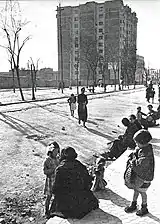
Throughout 1938 Casado developed doubts about the prime minister Negrín's strategy to keep on fighting. He was increasingly convinced that the war was already lost, and that further resistance would only produce unnecessary deaths, sufferings and destruction. He blamed the Communists for prolonging the war in the interest of the Soviet Union. Since late 1938 Casado engaged in talks with some politicians about forming an anti-Negrín opposition, and since early 1939 he entered into secret peace talks with the Nationalists. In February the conspiracy was already well developed; Casado was its undisputed leader, supported by most of the military command layer, the Anarchists and the Socialists.[14]
On March 5, 1939, the plotters declared constitution of Consejo Nacional de Defensa (CND), which claimed all power in the Republican zone; it was presented as a pre-emptive strike against imminent dictatorial Communist takeover. Casado was the key man behind CND; during a phone talk with Negrín he refused to budge. He temporarily acted as the CND president, but ceded the post to general Miaja the following day and within the body he assumed office as counselor of defence. It is not clear to what extent Casado was commanding CND-loyal troops during fightings against the Communist-loyal units, which went on in Madrid until March 11. Once CND assumed full control over the Republic Casado took part in some juridical proceedings, resulting in death sentences and execution of some Communist leaders, especially Luis Barceló.[15]
Casado and CND continued talks with the Nationalists. He intended to negotiate a staged surrender, evacuation of all these willing to leave Spain and no political repression afterwards; he might have even hoped for re-integration of professional Republican officers into the post-war army. The Nationalists demanded immediate and unconditional surrender;[16] no such document has been signed, but Casado eventually realised that further negotiations were pointless. On March 26 CND ordered no resistance to Nationalist advance, which commenced the next day. On March 28 Casado flew out of Madrid to Valencia. According to some sources he tried to arrange ships for mass evacuation and in his last radio broadcast he claimed they would be available in Alicante; according to others he did close to nothing in terms of enabling evacuation. On March 29 in Gandia Casado boarded a British warship, which set sail in the early hours of March 30.[17]
Exilee and retiree
Casado was transported to Marseille on a British hospital ship. He then travelled to the United Kingdom, most likely with approval of the London government. He received a stipend from the British Committee for Refugees from Spain; following intervention of the Foreign Office, his allowances were set at a higher rate than normally. In late 1939 he was given a job in the Spanish section of the BBC; he commented on military issues using the pseudonym of "Coronel Juan de Padilla".[18] According to some scholars, BBC World Service served as sort of a repository for individuals that British Intelligence thought potentially useful in the future.[19] He wrote The Last Days of Madrid, the book translated and published in record time; one author suspects MI6 was involved. It is not clear when his job at BBC was terminated and what he was doing for a living in the mid-1940s.
At some time Casado got professionally related to the Swiss multi-national food conglomerate Nestlé. In 1947 he left Britain for Colombia as employee of its Colombian subsidiary, Cicolac.[20] He might have hoped for some role in politics, as he speculated that following the end of World War Two and in the atmosphere of international anti-Franco ostracism, the British were likely to enforce the fall of Franco regime and see a role for him back in Spain. In 1949 he moved to Indulac,[21] the Nestlé subsidiary for Venezuela. He spent there 12 years, touring the country as a commercial representative. As he turned 60 and developed various health problems, since the mid-1950s the work was getting increasingly challenging.
In 1961 Casado returned to Spain; it is not clear whether before he had any contacts with the Francoist administration. He settled in Madrid at calle Cea Bermúdez and initially was not subject to any juridical or administrative harassment, and this was despite the fact that in 1943 he had been trialed by Tribunal Especial para la Represión de la Masonería y el Comunismo and in 1944 he was sentenced to 12 years in prison for rebellion.[22] However, as his Nestlé pension was hardly sufficient, in 1962 he applied for military pension; this triggered investigation, including focus on his role in Republican armed forces. Eventually charges of military rebellion were dropped, though he was briefly placed under house arrest. In 1966 he suffered a minor heart attack. To address ongoing financial problems, in 1967 he re-published The Last Days, in Spanish titled Así cayó Madrid; first serialised in a Falange periodical El Pueblo it was then issued as a book. It was re-edited to be even more damning to Negrín.[23]
Private life
In 1920 Casado married María de las Mercedes de la Calle Condado; none of the sources consulted provides any information either on her or on her family,[24] except that she survived the civil war.[25] The marriage did not last and produced no offspring. It is not clear whether the couple divorced or the marriage was annulled.[26] At unspecified time, either in the early or in the mid-1930s, Casado married María del Carmen Santodomingo de Vega (1911-1976).[27] They had 2 children: Carmen and Segismundo Casado Santodomingo, born in the mid-1930s. In unclear circumstances the family got separated upon Casado leaving Spain in 1939; his wife and children remained in the country and initially sought refuge in the diplomatic legacy of Panama. As the premises were stormed by the Francoists she was imprisoned and initially held in a cell with prostitutes. Later the family were denied passports. Casado's efforts to secure their exit, aided informally by the British diplomacy in the early 1940s, proved fruitless.[28]
In the early 1940s Casado entered into an intimate relationship with an Englishwoman, Norah Purcell, just divorced from a colonial administrator and sinologist Victor Purcell; she later gained some recognition as a translator from French . They lived together for six years and had a daughter, María Cristina (surname unclear), who died in 1946.[29] For reasons which remain unknown the union ended with Casado's departure for Latin America, though apparently Casado was still in love and tried to maintain amorous correspondence at least until the early 1950s. In 1951 he was re-joined by his wife and both children in Venezuela. However, he soon concluded that they were “totally incompatible” and suggested she goes back to Spain; details and background of their differences are not known. Nevertheless, the family lived together. Carmen accompanied Casado when he returned to Spain; the children remained in Venezuela.[30]
Casado had at least one brother, César; it is not clear who of the siblings was older. He also became a professional cavalry officer and both brothers progressed almost simultaneously through the ascension ladder, e.g. in 1913 both were segundos tenientes,[31] in 1923-1924 both were capitanes,[32] and in 1936 both were comandantes.[33] He was recorded as related to the Madrid branch of the Anarchist trade union CNT.[34] During the civil war he sided with the Republicans and in July 1938 as mayor de caballería was assigned “a las ordénes de la Subsecretaria de Tierra” in the Ministry of Defense.[35] The position he took during the coup of March 1939 is not clear. It is known, however, that the brothers fell apart and after the war Segismundo explicitly forbade his children to accept any financial help from César.[36]
Outlook and political views
.svg.png.webp)
Casado's political views are not entirely clear, though he was without doubt a man of the Left. In his publications and in his private correspondence he used to refer to his childhood, spent in misery and poverty of the rural working class, which reportedly made him sensitive to social injustice. This might not seem compatible with his entry into professional military service, as at the time the army along the monarchy and the Church were considered pillars of the regime, though on the other hand he was only 15 when applying to the military academy. There is no trace of his political engagements until he was in his early 30s. He did not welcome the Primo de Rivera dictatorship; in own papers Casado refers to himself as a rebel, though there is no evidence of any rebellious activity recorded. However, indeed at least twice he appeared in military courts defending fellow officers charged with conspiracy against the regime.[37]
Despite reversion of his promotion to comandante Casado did not seem to harbor any grievances against the Republic. Though he did not engage in open politics, he must have been considered a loyal republican officer when in 1935 nominated to commander of personal presidential guard, even given at the time the Right was in power. There is no doubt as to his loyalty to the Republic following the coup d'état of July 1936, which was far more than simple “lealtad geográfica” of many professional officers trapped in the Republican zone. Some scholars claim that in late 1936 he developed a particular knack against the Communists, as he blamed them for his sidetracking from General Staff operations towards other organisational work; he is presented as a man “eaten up with resentment”, though on personal rather than political grounds.[38] His brother seemed related to the Anarchist CNT, but there is no evidence that Segismundo was close to Anarchism; neither there is any data which points to his relation to Socialism. Some authors claim that "he broadly shared Azaña's view of politics",[39] which points to radical left-wing republicanism.
In his own papers and in some historiographic literature Casado is pictured as a man of decisively progressist outlook, determined to fight for democracy, liberty and social justice against any sort of dictatorship – be it a Communist or a Francoist one.[40] It is not clear whether Casado was a Catholic; it is known that some time in the 1920s he joined the freemasonry,[41] which was not necessarily incompatible with some sort of unorthodox, liberal Catholicism. Either from childhood or from some point in his adult life he embraced anti-Semitism. In his papers from the 1950s he refers abusively to Franco as the “Jewish dwarf”; at the same time, when engaged in fruitless discussions on changing his travelling work pattern in Venezuela, he blamed his managers from Indulac for “Jewish mentality”.[42] However, he remained reasonably tractable and for decades he was engaged in at least correct epistolographic exchange with correspondents as distant as Indalecio Prieto, Salvador de Madariaga, Cipriano Mera and the Alfonsist pretender Juan de Borbón.
In public discourse
.jpg.webp)
In popular discourse of Francoist Spain Casado was rather absent; if mentioned, he was noted as the one who mounted a pre-emptive anti-Communist strike.[43] This was the thesis repeated also in academic historiography.[44] In his monumental work on the Spanish Civil War, written in the 1960s, Hugh Thomas presented Casado as a man much less far-sighted than Negrín and perhaps guilty of some political naivete; however, from the narrative he still emerged as a well-intended person, even if somewhat guided by personal grievances against PCE.[45] Casado's Asi cayo Madrid was rather well received by critics; reviewers presented the book as defense against absurd Communist charges of surrendering the Republic “cuando el pueblo quería continuar la lucha”.[46] Following his death newspapers adhered to a very matter-of-fact tone, at times again presenting him as a man who prevented a Communist coup.[47] In the early 1970s a historian Ricardo de la Cierva referred to him as “destacado teórico y técnico militar”.[48]
Since the 1980s most scholars concluded there was no Communist coup d'état planned, which dismantled part of the rationale behind the 1939 coup. Instead of pointing to a coup against “Communist-dominated government”, some authors started to note a coup “against the legal government”.[49] Casado's personal motivations were increasingly focused on, with emphasis on excessive ambition.[50] The advent of social and digital media produced an array of opinions, from these lambasting Casado as traitor[51] to these counting him among heroes and great patriots,[52] and voices in-between.[53] In historiography the coup was increasingly viewed not as an act to stop further killing, but as an avoidable error which facilitated the triumph of Francoist dictatorship.[54] Major onslaught on Casado was launched by Paul Preston; his 2016 work presented Casado as a man obsessed with own ambition who precipitated a massive humanitarian disaster.[55] In 2018 author Pedro López Ortega published a book which advanced the opposite view: Casado “represented realism and humanitarian sensitivity against folly and fanaticism of the others”.[56]
In his native town of Nava de la Asunción until recently there was a minor street named after Casado,[57] but it was renamed and currently in Spain there is none. In 1976 José María Rodríguez Méndez wrote Ultima batalla en El Pardo, a theatrical drama centred on the 1939 coup; its protagonists were Franco and Casado. The work deals with the question of an individual facing great events and does not appear to take sides;[58] it was not published until the 1990s and in the 21st century made it to stage.[59] Casado featured as a protagonist in a few Spanish novels, set in Madrid of early 1939.[60] In Spanish public discourse it is at times claimed that the iconic actor known as Fernando Rey (Fernando Casado) was the son of Segismundo Casado;[61] in fact, he was son to another Republican military.[62]
References
- Segismundo Casado López, [in:] Real Academia de Historia service
- see e.g. Angel Viñas, Casado López, Segismundo, [in:] Javier Garcia Fernández, 25 militares de la República, Madrid 2020, ISBN 9788490914403, p. 213
- some claim that in 1908, Viñas 2020, p. 213
- military career of Casado referred after Segismundo Casado López, [in:] Real Academia de Historia service, and Biografía de Segismundo Casado, [in:] La Biografía service. In case there are discrepancies between two sources, they are noted
- Vinas 2020, p. 213
- Vinas 2020, p. 213
- Anuario Militar de España 1924, p. 634
- La Correspondencia Militar 19.07.1928
- El Año Politico 1927, p. 84
- Gaceta jurídica de guerra y marina 01.12.1929
- Segismundo Casado López, [in:] Real Academia de Historia service
- Biografía de Segismundo Casado, [in:] La Biografía service
- Preston 2016, p. 24
- Paul Preston, The Last Days of the Spanish Republic, London 2016, ISBN 9780008163419, pp. 87-115
- Preston 2016, pp. 211-236
- Antony Beevor, The Battle for Spain. The Spanish Civil War 1936-1939, London. 2006, pp. 394-395
- Preston 2016, pp. 286-297
- also "Coronel Padilla" and "Coronel Lelo Portela", Vinas 2020, p. 240
- opinion of Angel Vinas, referred after Preston 2016, p. 310
- Compania Colombiana de Productos Lactas, Vinas 2020, p. 240
- Industrias Lacteas Venezolanas, Vinas 2020, p. 240
- Vinas 2020, p. 239
- Preston 2016, pp. 310-317
- Biografía de Segismundo Casado, [in:] La Biografía service. Some sources claim her name was Maria de las Mercedes Condado y Condado, Preston 2016, p. 307
- in 1939 Casado explitictly forbade his children to accept financial help from her, Preston 2016, p. 307
- one scholar suspects that they either divorced or Casado was widowed, Vinas 2020, p. 213
- Fallecidos, [in:] El País 05.08.1976
- Preston 2016, pp. 310-311
- Agustín Carreras Zarama, El archivo privado de don Rafael Fernández de la Calzada y Ferrer, [in:] Boletín Informativo Sistema Archívistico de la Defensa 13 (2007), p. 10
- in 2018 Segismundo Casado Santodomingo, aged 82, lived in Caracas. Casado had one grandchild, Ivana, who currently lives in Italy, Texto de Presentación, [in:] Instituto Castellano y Leonés de la Lengua service 2018, p. 11
- Annuario Militar de España 1913, p. 46
- Annuario Militar de España 1923, p. 288
- El Siglo Futuro 14.01.1936
- Ficha de Cesar Casado Lopez, [in:] Centro Documental de la Memoria Histórica
- El dia grafico 30.07.1938
- Preston 2016, p. 307
- El Año Politico 1927, p. 84, Gaceta jurídica de guerra y marina 01.12.1929
- Preston 2016, p. 24
- Hugh Thomas, The Spanish Civil War, London 2001, ISBN 0375755152, p. 299
- see Pedro López Ortega, Coronel Segismundo Casado López. Defensor de la Justicia, la Libertad y la República, Sevilla 2018, ISBN 9788417146474
- he joined "la logia masonica madrilena Hispano-Americana no. 2" under the name of "Berenguer", Vinas 2020, p. 213
- Preston 2016, p. 315
- ABC 31.03.1944
- Antonio Ballesteros Beretta, Síntesis de historia de España, Madrid 1952, p. 558; José Manuel Cuenca Toribio, Historia de España, vol. 2, Madrid 1973, p. 388
- Thomas 2001, pp. 861-884. He was described as “able, cultivated, austere and hard-working; he lived as simply as if he were the most junior soldier, and worked as if he were the commander-in-chief, Thomas 2001, p. 863
- El libro español 135 (1969), ABC 09.05.1968
- Diario de Burgos 19.12.1968
- Ricardo de la Cierva, Historia ilustrada de la guerra civil española, vol. 2, Madrid 1973, p. 493
- R. H. Haigh, D. S. Morris, Anthony R. Peters, The Guardian Book of the Spanish Civil War, London 1987, ISBN 9780704530805, p. 316
- compare "anticomunista furibundo con no pocas angustias por la frustración de su carrera", Ramón Tamames, España 1931-1975; una antológia histórica, Madrid 1980, ISBN 9788432056598, p. 209
- Agustín Monzón, La traición de Casado, [in:] El Independiente 02.03.2019
- Segismundo Casado – heroes de la Republica, [in:] YouTube service, Agustin Hidalgo, El Coronel Casado, gran militar y patriota, [in:] El Confidencial 06.09.2021
- Alfonso Vila Francés, Casado, ¿Heroe o traidor?, [in:] Le Miau Noir blog,
- Angel Viñas, Fernando Hernández Sánchez, El golpe de Casado y el final de la guerra, [in:] El País 05.03.2009
- Preston 2016
- "encarnó el realismo y el sentimiento humanitario frente a la insensatez y el fanatismo de otros"", see marketing information at Libreralia service
- Callejero.Net service
- ABC 15.05.1992
- ABC 28.03.2001
- see e.g. Pedro Corral, La ciudad de la Arena, Madrid 2009
- ABC 16.04.2001
- La Vanguardia 02.08.2017
Further reading
- Francisco Alía Miranda, La agonía de la República: El final de la guerra civil española (1938-1939), Barcelona 2015, ISBN 9788498927979
- Angel Bahamonde Magro, Madrid, 1939: la conjura del coronel Casado, Madrid 2014, ISBN 9788437632674
- Angel Bahamonde Magro, Javier Cervera Gil, Así terminó la guerra de España, Barcelona 2000, ISBN 8495379090
- Luis Español Bouché, Madrid 1939: del golpe de Casado al final de la Guerra Civil, Madrid 2004, ISBN 9788496170087
- Pedro López Ortega, Coronel Segismundo Casado López. Defensor de la Justicia, la Libertad y la República, Sevilla 2018, ISBN 9788417146474
- Paul Preston, The Last Days of the Spanish Republic, London 2016, ISBN 9780008163419
.jpg.webp)
